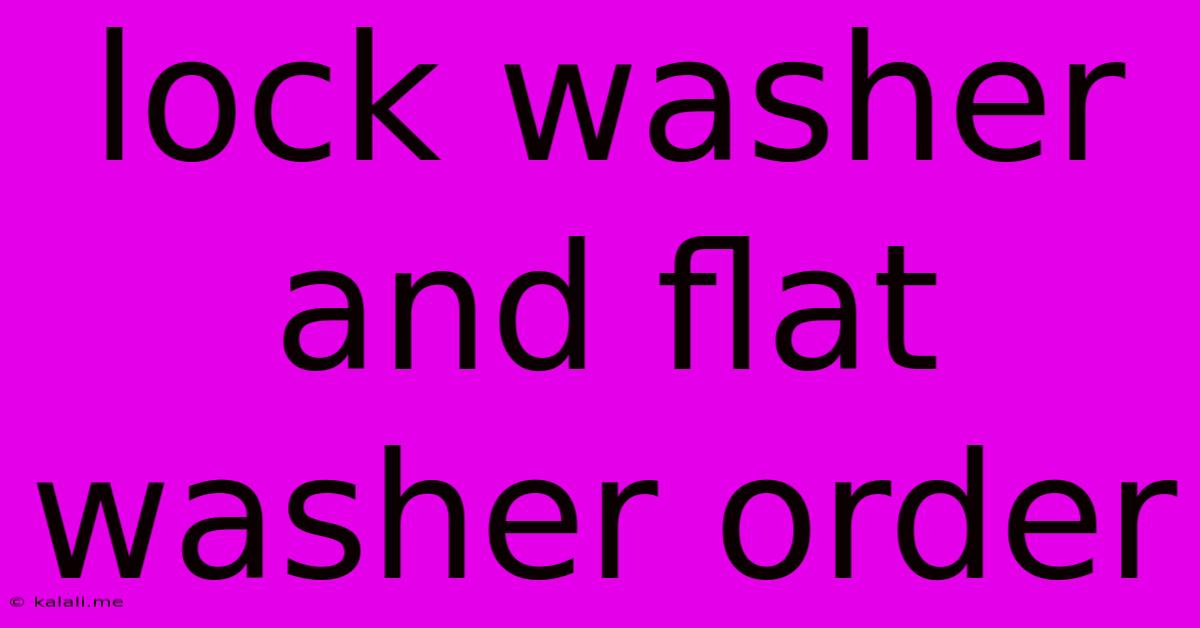Lock Washer And Flat Washer Order
Kalali
May 24, 2025 · 3 min read

Table of Contents
Lock Washer vs. Flat Washer: Understanding the Correct Order and Application
Choosing between a lock washer and a flat washer, and understanding their correct order during assembly, is crucial for ensuring a secure and reliable fastening. This article will clarify the differences, explain the proper sequence, and delve into the reasons behind this crucial detail. Improper washer placement can lead to loose screws, component failure, and even safety hazards.
What are Lock Washers and Flat Washers?
-
Flat Washers: These simple, disc-shaped components distribute the clamping force of a fastener over a wider area, preventing damage to the underlying surface. They improve the overall clamping efficiency and prevent the nut or bolt head from digging into the material.
-
Lock Washers: These washers are designed to prevent loosening of fasteners due to vibration or other external forces. Several types exist, each with a unique locking mechanism: spring lock washers, tooth lock washers, internal tooth lock washers, and external tooth lock washers. They create friction or a gripping mechanism to keep the fastener secure.
The Correct Order: Why It Matters
The correct order is always flat washer (if used), then lock washer, then the nut or bolt head. Here's why:
-
Force Distribution: The flat washer sits first, distributing the clamping force evenly across the surface. This prevents the lock washer from concentrating stress in a small area, potentially damaging the material or compromising the lock washer's effectiveness.
-
Lock Washer Functionality: Placing the lock washer on top allows it to engage properly with the nut or bolt head. If placed under the flat washer, its locking mechanism might not engage correctly, rendering it ineffective. The flat washer provides a smooth surface for the lock washer to grip.
-
Preventing Damage: If a lock washer were placed directly against the surface, its sharp edges or teeth might damage or mar the material. The flat washer acts as a protective layer.
When to Use a Flat Washer with a Lock Washer
While a lock washer alone might suffice in some applications, using a flat washer in conjunction offers several advantages:
-
Increased Surface Area: A flat washer increases the contact area between the fastener and the material, improving the overall clamping force and preventing damage to the material.
-
Improved Seal: In some applications, a flat washer can provide a better seal, preventing leaks or the ingress of contaminants.
-
Better Vibration Dampening: The combination of a flat washer and a lock washer provides improved vibration dampening compared to using just a lock washer.
When to Use Only a Lock Washer
In situations where space is extremely limited or the application doesn't require the added benefits of a flat washer, a lock washer alone might suffice. However, always prioritize the application requirements and choose the option that offers the best security and protection.
Different Types of Lock Washers and Their Applications
Choosing the right type of lock washer is as crucial as the order. The choice depends on the application, the material, and the expected level of vibration and stress:
-
Spring Lock Washers: Ideal for general-purpose applications with moderate vibration.
-
Tooth Lock Washers: Best suited for applications with high vibration or shock loads, providing a strong bite to prevent loosening.
-
Internal Tooth Lock Washers: Provide excellent locking power in applications where space is limited.
-
External Tooth Lock Washers: Similar to internal tooth lock washers but with the teeth on the outer edge.
In summary, understanding the correct order of flat washers and lock washers – flat washer (if used), lock washer, then nut or bolt head – is essential for reliable fastening. This sequence optimizes the performance of both components, ensuring a secure and lasting connection. Remember to select the appropriate type of lock washer based on the specific demands of your project.
Latest Posts
Latest Posts
-
How To Stop Minecraft From Pausing When Tabbing Out
May 25, 2025
-
I Want The Not The Weather
May 25, 2025
-
How To Say Bless U In Portu
May 25, 2025
-
What Does It Say In The Bible About Circumcision
May 25, 2025
-
How Long Does Chili Last In The Fridge
May 25, 2025
Related Post
Thank you for visiting our website which covers about Lock Washer And Flat Washer Order . We hope the information provided has been useful to you. Feel free to contact us if you have any questions or need further assistance. See you next time and don't miss to bookmark.